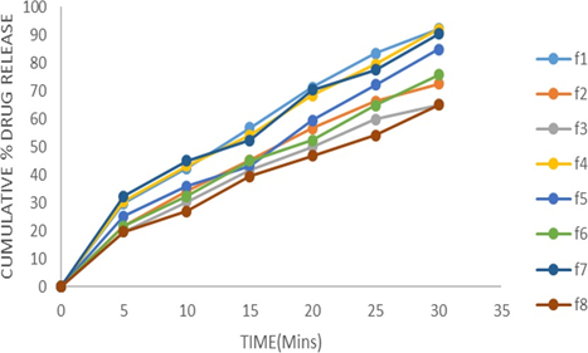Abstract
The present research dealt with the extraction and characterization of mucilage from the Hibiscus sabdariffa leaves. Compared with normal binding agents such as starch and Poly Vinyl Pyrrolidine (PVP), the mucilage of Hibiscus sabdariffa (HSM) was assessed for its binding properties in tablet formulations. Tablets were formulated using HSM, starch and PVP as binders at a various concentration to evaluate its comparative binding efficiency. The compressed tablets were analyze for their quality control tests as per IP. The extracted HSM showed the characteristics of mucilage and good physicochemical properties. The FTIR and thermal analysis compatibility tests showed that there were no significant reactions between the drug and mucilage. Granule properties of various formulations were found to be comparable and have excellent flow characteristics. Post compression parameters suggested that tablets formulated with mucilage had better hardness and friability as that of the tablets prepared with starch and PVP. The formulations exhibited a better and more consistent release as compared to standard formulations using starch and PVP as a binder. The statistical analysis of in vitro dissolution profile by using DD solver software for difference factor (f1), similarity factor (f2), and Rescigno index (ξ) values also indicated promising results. The results notably indicate that binding property of HSM was at par with starch and PVP.
Full text article
References
Choudhary, P. D., Pawar, H. A. 2014. Recently Investigated Natural Gums and Mucilages as Pharmaceutical Excipients: An Overview. Journal of Pharmaceutics, 2014:1–9.
Eggensperger, H., Wilker, M. 1996. Hibiscus Extrakt - Ein hautvertraglicher Wirkstoffkomplex aus AHA’a und polysacchariden. Parfumerie Und Kosmetik, 9:540–543.
Eslaminejad, T., Zakaria, M. 2011. Morphological characteristics and pathogenicity of fungi associated with Roselle (Hibiscus Sabdariffa) diseases in Penang, Malaysia. Microbial Pathogenesis, 51(5):325–337.
Gayathri, R., Sundaraganapathy, R. 2019. Design, optimization and comparative in vitro evaluation of sustain release matrix tablet using araucaria heterophylla gum. International Journal of Research in Pharmaceutical Sciences, 10(3):2109– 2116.
Morton, J. 1987. In: Fruits of Warm Climates. University of Michigan, pages 189–293.
Nayak, B. S., Ellaiah, P., Sethy, S., Sahoo, S., Sarangi, B. K. 2015. Evaluation of solanum surattens linn. mucilage as tablet binder. World Journal of Pharmacy and Pharmaceutical Sciences, 4(3):1370– 1385.
Ngwuluka, N. C., Idiakhoa, B. A., Nep, E. I., Ogaji, I., Okafor, I. S. 2010. Formulation and evaluation of paracetamol tablets manufactured using the dried fruit of Phoenix dactylifera Linn as an excipient. Research in Pharmaceutical Biotechnology, 2(3):25–032.
Okonkwo, T. J. N. 2010. Hibiscus sabdariffa anthocyanins: a potential two-colour end-point indicator in acid-base and complexometric titrations. Int J Pharm Sci Rev Res, 4:123–131.
Pant, S., Sharma, P. K., Malviya, R. 2015. Evaluation of different concentration of binders on the dissolution profile of paracetamol tablets. Advances in Biological Research, 9(2):82–85.
Priyanka, S., Vandana, S. 2013. A review article on: superdisintegrants. International Journal of Drug Research and Technology, 3(4):76–87.
Rocha, I. D.-C., Bonnlaender, B., Sievers, H., Pischel, I., Heinrich, M. 2014. Hibiscus sabdariffa L. – A phytochemical and pharmacological review. Food Chemistry, 165:424–443.
Rupa, S., Banik, J. K. 2011. Evaluation of Hibiscus sabdariffa leaf mucilage. International Journal of Pharmacy and Pharmaceutical Sciences, 3:184– 187.
Shende, M. A., Marathe, R. P. 2015. Extraction of mucilages and its comparative mucoadhesive studies from hibiscus plant species. World journal of pharmacy and pharmaceutical sciences, 4(3):900–924.
Singh, P., Mahmood, T., Shameem, A., Bagga, P., Ahmad, N. 2016. A review on Herbal Excipients and their pharmaceutical applications. Sch Acad J Pharm, 5(3):53–60.
Tavakoli, N., Ghassemi-Dehkordi, N., Teimouri, R., Hamishehkar, H. 2007. Characterization and evaluation of okra gum as a tablet binder. Jundishapur Journal of Natural Pharmaceutical Products, 2008:33–38.
Wang, M. L., Morris, B., Tonnis, B., Davis, J., Pederson, G. A. 2012. Assessment of Oil Content and Fatty Acid Composition Variability in Two Economically Important Hibiscus Species. Journal of Agricultural and Food Chemistry, 60(26):6620–6626.
Authors

This work is licensed under a Creative Commons Attribution-NonCommercial-NoDerivatives 4.0 International License.

